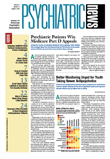Schools have implemented a variety of programs to reduce suicide among at-risk teenagers. Though there is not definitive evidence linking them to decreased suicide rates, the programs do have a positive effect on students, according a panel of experts on teen suicide who spoke at APA's annual meeting in Toronto in May.
The workshop on school-based suicide prevention was sponsored by APA's Corresponding Committee on Mental Health and Schools.
Approximately 2,000 American adolescents between the ages of 13 and 19 commit suicide each year, according to LaShondra Washington, M.D., a PGY-4 resident at the University of Maryland's Division of Child and Adolescent Psychiatry. About 2 million adolescents attempt suicide each year and, of them, 700,000 harm themselves to the extent that they require medical attention.
In a 2001 survey cited by Washington and conducted by the Centers for Disease Control and Prevention, 19 percent of a representative sample of high school students seriously considered suicide, 14.8 percent devised a plan to commit suicide, 8.8 percent attempted suicide, and 2.6 received medical attention for the attempt.
Precipitants of a suicidal crisis include the death of a family member or friend or other type of loss, school disciplinary action, involvement with police or the legal system, or a humiliating event, Washington explained.
Psychiatric illnesses such as mood, developmental, borderline personality, and conduct disorders can be risk factors for a suicide attempt, as can drug or alcohol abuse, impulsive or aggressive behavior, sexual or physical abuse, and previous suicide attempts.
Race, Ethnicity Can Play Role
Psychiatrists should also take into consideration risk factors associated with race and ethnicity, according to Eugenio Rothe, M.D., an associate professor of psychiatry at the University of Miami School of Medicine and chair of the Corresponding Committee on Mental Health and Schools.
In studies on adult Hispanics in the United States, he noted, acculturation has been found to have deleterious effects on mental health. In youth, the same may be true.
A study that Rothe helped conduct comparing suicidal behavior among a group of 4,157 Mexican youth living on both sides of the U.S. border found that suicidal thoughts were more prevalent among those living on the U.S. side.
“This was true even when controlling for depression, substance abuse, and comorbid depression with substance abuse,” he said.
Vanishing Family Ties Contribute
Mexican youth with the highest rates of suicidal ideation spent little or no time with their families, more time unsupervised with peers or in front of the TV, and more time working in part-time jobs outside the home, according to Rothe's findings, which are not yet published. He explained that Mexican youth who undergo the process of acculturation after immigrating to the United States often lose the support of their extended families and sometimes religious beliefs that may protect against suicide.
School personnel are in a strategic position to reduce the prevalence of teen suicide, but there is no consensus on how this should be accomplished, according to Daniel Castellanos, M.D., an associate professor of psychiatry at the University of Miami School of Medicine.
“Further work is needed to systematically evaluate the effectiveness of these programs in reducing teen suicide,” he said.
Some schools try to reduce suicide risk by employing mental health professionals as a way to increase access to mental health services, he noted. One problem with this is that conduct problems are associated with suicide risk, according to Castellanos, and those with conduct problems may tend to skip school.
Other school-based suicide prevention programs incorporate skill-building exercises to improve students' ability to solve problems and adapt to stress, he noted.
Most school-based suicide prevention programs use psychoeducational approaches to teach students how to recognize suicidal risk in themselves and their peers, encourage help seeking, and reduce the stigma associated with help seeking.
Psychoeducational programs “can have a positive effect on knowledge and attitudes toward suicide,” Castellanos said.
One program that has received national acclaim in recent years is the“ When Not to Keep a Secret” essay contest, launched in 1998 by the APA Alliance to encourage teens to enlist the help of an adult when a friend indicates that he or she is considering suicide or violence or is struggling with symptoms of a psychiatric illness.
The APA Alliance is an educational and charitable organization established to address youth violence and increase public awareness of mental health issues and resources.
Alliance President Kay Grada, who also spoke at the workshop, said that 80 percent of the essays received as part of the project deal with suicide.
“It amazes me how many young people don't trust adults at all, and this comes out in their essays,” she said. “Our intent is to create a positive environment for open communication between the students, the students and their parents, teachers, or another trusted adult.”▪

